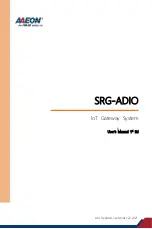
To configure your video network for Cisco telepresence, you need to configure the following
deployment components: SCOPIA TIP Gateway, SCOPIA Management, and SCOPIA Elite MCU.
You also need to confirm that the CUCM, Cisco's Call Manager, is properly configured for the
SCOPIA Solution.
Note
Only the personnel that installed the Cisco telepresence and the customer's network
administrator can modify the Cisco telepresence configuration.
SCOPIA Management does not require any specific license for supporting telepresence but is
aware of the MCU telepresence license to deliver warning messages to administrators and for
display purposes.
This section guides you through the steps required to integrate Cisco telepresence with
SCOPIA Solution, as follows:
1.
Verifying the CUCM Settings for SCOPIA Management ................................. page 23
2.
Configuring Ports on the SCOPIA TIP Gateway .......................................... page 25
3.
Configuring the SCOPIA TIP Gateway in SCOPIA Management ........................ page 28
4.
Configuring Cisco Telepresence in SCOPIA Management .............................. page 33
5.
Configuring SCOPIA Elite MCU for Cisco Telepresence ................................ page 40
Verifying the CUCM Settings for SCOPIA Management
The Cisco Unified Call Manager (CUCM) can be configured as a SIP proxy with SCOPIA
Solution’s components by defining a SIP trunk from the CUCM to the SCOPIA Management, and
defining routing patterns which are aligned with the overall dial plan of the network.
Perform this procedure to confirm the SIP trunk includes the special settings required for
routing video, audio, and data to the SCOPIA Solution.
5
Configuring your SCOPIA Solution for
Interoperability with Cisco Telepresence
RADVISION | Deployment Guide for SCOPIA TIP Gateway Version 8.0
Configuring your SCOPIA Solution for Interoperability with Cisco Telepresence | 23
















































